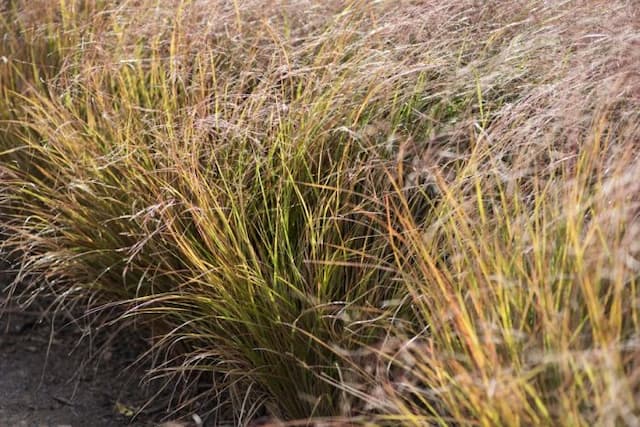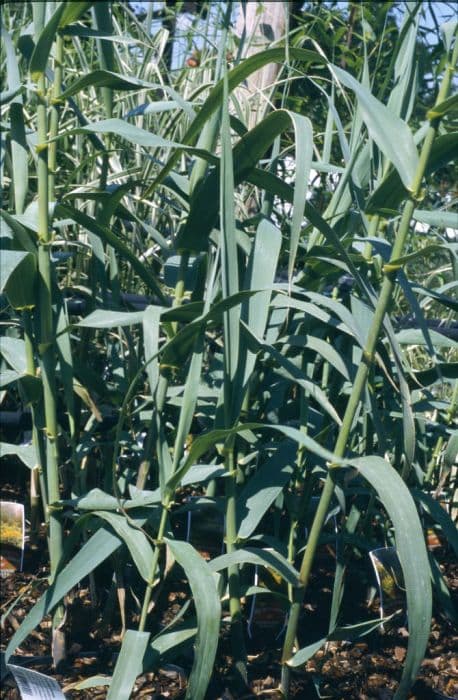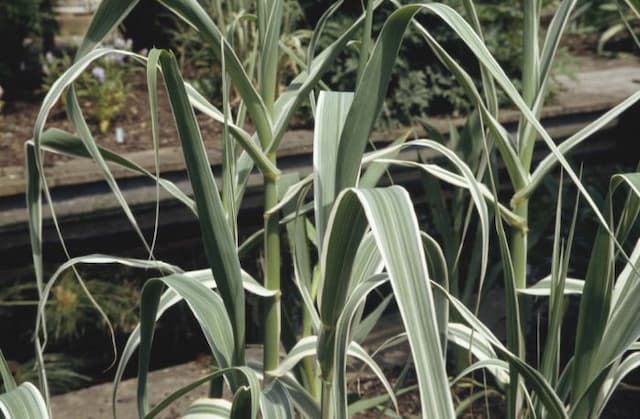Oriental fountain grass Pennisetum orientale

ABOUT
Pennisetum orientale, commonly known as Oriental fountain grass, is a perennial grass that is valued for its graceful, fountain-like form and delicate texture. Its slender leaves are a vibrant green, arching outwards with a gentle droop, giving a soft, fluffy appearance to the clump. During the warmer months, the plant produces airy flower plumes that seem to dance atop the narrow stems. These feathery flowers are a soft pink or pale purple, adding a touch of color and movement to the garden. The flower spikes resemble bottle brushes and can persist on the plant, providing visual interest even as they fade to a tan or buff color. Oriental fountain grass has a mounding habit, which makes it an attractive feature in many landscape designs, as it brings contrast with its soft texture against other plants with thicker, broader leaves.
About this plant
 Names
NamesFamily
Poaceae
Synonyms
Oriental Fountain Grass, Oriental Pennisetum
Common names
Cenchrus orientalis, Pennisetum villosum, Pennisetum lanatum.
 Toxicity
ToxicityTo humans
Oriental Fountain Grass is not known to be toxic to humans. Therefore, ingestion of this plant is not typically associated with poisoning or toxic symptoms in humans.
To pets
Oriental Fountain Grass is also not known to be toxic to pets. While it is generally considered non-toxic, ingestion of any plant material by pets can sometimes cause mild gastrointestinal upset such as vomiting or diarrhea due to the irritation of the stomach or intestines.
 Characteristics
CharacteristicsLife cycle
Perennials
Foliage type
Deciduous
Color of leaves
Green
Flower color
Pink
Height
2 feet (0.61 meters)
Spread
2 feet (0.61 meters)
Plant type
Herb
Hardiness zones
5
Native area
Asia
Benefits
 General Benefits
General Benefits- Landscape Ornamentation: Oriental fountain grass is valued for its graceful, fountain-like foliage and foxtail-shaped blooms, enhancing the aesthetic appeal of gardens and landscapes.
- Erosion Control: Because of its robust and tightly clumping growth habit, it can help to stabilize soil and prevent erosion.
- Drought Tolerance: This plant is drought-tolerant once established, making it ideal for water-wise landscaping in arid regions.
- Low Maintenance: It requires minimal upkeep beyond the occasional trimming to remove spent foliage and maintain its shape.
- Wildlife Habitat: The flower plumes can provide seeds that are attractive to birds, while the dense foliage can offer shelter to various wildlife species.
- Seasonal Interest: Oriental fountain grass has a long blooming season, providing visual interest from mid-summer to fall with its feathery plumes that can also add winter interest if left uncut.
 Medical Properties
Medical PropertiesThis plant is not used for medical purposes.
 Air-purifying Qualities
Air-purifying QualitiesThis plant is not specifically known for air purifying qualities.
 Other Uses
Other Uses- Pennisetum orientale, commonly known as Oriental fountain grass, can be used in the creation of dried flower arrangements due to its attractive fluffy flower heads which maintain their shape and texture after drying.
- Its dense clumping growth habit makes Oriental fountain grass an effective choice for erosion control on slopes and banks, as its roots help stabilize the soil.
- This grass is also used in garden ponds and water features as an ornamental plant, providing vertical interest and movement with its feathery plumes.
- Oriental fountain grass can be used as a natural screen or privacy barrier in landscaping because of its height and density when planted in groups.
- The plant can be incorporated into wildlife gardens as its seeds provide food for birds, while the dense foliage offers shelter for small animals.
- In crafting, the plumes of the Oriental fountain grass can be used to make natural brooms or brushes.
- The grass can function as a sound barrier when planted en masse, helping to reduce traffic noise in urban landscaping projects.
- As part of a xeriscape garden design, which requires minimal irrigation, Oriental fountain grass can add texture and movement with very low water needs.
- Oriental fountain grass may be utilized in season extension gardening, offering visual interest in the garden even in late fall and winter after other plants have died back.
- For photographers and artists, the grass serves as an appealing subject for nature photography and botanical illustration due to its distinctive form and seasonal color changes.
Interesting Facts
 Feng Shui
Feng ShuiOriental fountain grass is not used in Feng Shui practice.
 Zodiac Sign Compitability
Zodiac Sign CompitabilityOriental fountain grass is not used in astrology practice.
 Plant Symbolism
Plant Symbolism- Prosperity: The lush, fountain-like appearance of Oriental Fountain Grass (Pennisetum orientale) often symbolizes prosperity, with its robust growth and graceful form representing abundance and wealth.
- Resilience: This plant can tolerate a range of conditions and its ability to bounce back from adversity represents resilience and the ability to endure challenges.
- Grace: With its elegant and slender foliage that sways gently in the breeze, Oriental Fountain Grass is associated with gracefulness and poise.
- Privacy: Often used as a screen in gardens, it symbolizes the need for privacy and creating personal space.
- Flexibility: The flexible stems that move with the wind reflect the idea of flexibility and the importance of going with the flow in life.
 Water
WaterOriental fountain grass should be watered deeply but infrequently, allowing the soil to dry out slightly between waterings. Typically, providing about 1 to 1.5 inches of water per week is adequate, depending on the climate and soil type. During hot and dry periods, water needs may increase - monitor the plant's health and moisture level in the soil to determine if additional water is necessary. Overwatering can lead to root rot, so it is vital to ensure good drainage. During the winter months, reduce watering frequency as the plant's growth slows down and its water requirements decrease.
 Light
LightOriental fountain grass thrives in full sun, where it receives at least six hours of sunlight each day. The ideal spot is an area with direct, unfiltered sunlight for most of the day. If grown in too much shade, the grass may not flower as prolifically and its form can become loose and less attractive.
 Temperature
TemperatureOriental fountain grass prefers temperatures within the range of 40 to 90 degrees Fahrenheit for healthy growth, though it can tolerate temperatures slightly outside this range for short periods. It's not very frost-tolerant, so the ideal temperature conditions would generally hover above 40 degrees Fahrenheit to avoid damage to the foliage.
 Pruning
PruningPruning Oriental fountain grass helps to maintain its size, shape, and to remove old foliage to make way for new growth. It should be cut back to about 3 to 4 inches above ground level in the late winter or early spring before the new growth starts. Pruning once a year is generally enough for this plant.
 Cleaning
CleaningAs needed
 Soil
SoilOriental fountain grass prefers well-draining soil with a loamy texture and a neutral to slightly acidic pH, typically around 6.0 to 7.0. The best soil mix would be a combination of garden soil, sand, and compost to ensure good drainage and fertility.
 Repotting
RepottingOriental fountain grass is typically not repotted as it is a perennial grass planted directly in the garden. However, if grown in containers, it can be repotted every 2-3 years or when it seems root-bound.
 Humidity & Misting
Humidity & MistingOriental fountain grass is tolerant of a wide range of humidity levels and does not have specific requirements, making it well-suited for different outdoor environments.
 Suitable locations
Suitable locationsIndoor
Provide full sunlight and well-draining soil.
Outdoor
Plant in full sun with space for clumps to spread.
Hardiness zone
6-9 USDA
 Life cycle
Life cyclePennisetum orientale, commonly known as Oriental fountain grass, begins its life cycle as a seed that germinates when soil temperatures warm in spring. The seedling emerges and develops into a tufted plant, growing in clumps and producing narrow, arching leaves. As the plant matures, it produces distinctive fluffy flower spikes that rise above the foliage in mid-summer to fall, attracting pollinators and providing visual interest. After pollination, seeds are set within the spent flowers, which then dry and disperse in the wind; the plant may also spread vegetatively through its rhizomes. In winter, Oriental fountain grass becomes dormant, with foliage browning and dying back, especially in cooler climates where it is grown as an annual. In spring, if conditions allow, the plant will regrow from its root system or from self-sown seeds, completing the cycle.
 Propogation
PropogationPropogation time
Spring-Early Summer
Oriental fountain grass (Pennisetum orientale) is most frequently propagated through division, a method where the clump of the grass is split into smaller portions. This should ideally be done in the spring, as the plant emerges from dormancy and begins active growth, ensuring that the divisions can establish well throughout the growing season. To propagate by division, dig up the entire clump of grass, ensuring you’ve got as much of the root system as possible, and then use a sharp knife or spade to divide the clump into smaller sections. Each section should have a good amount of roots and several shoots to ensure successful growth. After division, the sections can be planted back into the ground or into pots, given ample water to help establish, and placed in full sun to partial shade conditions.









